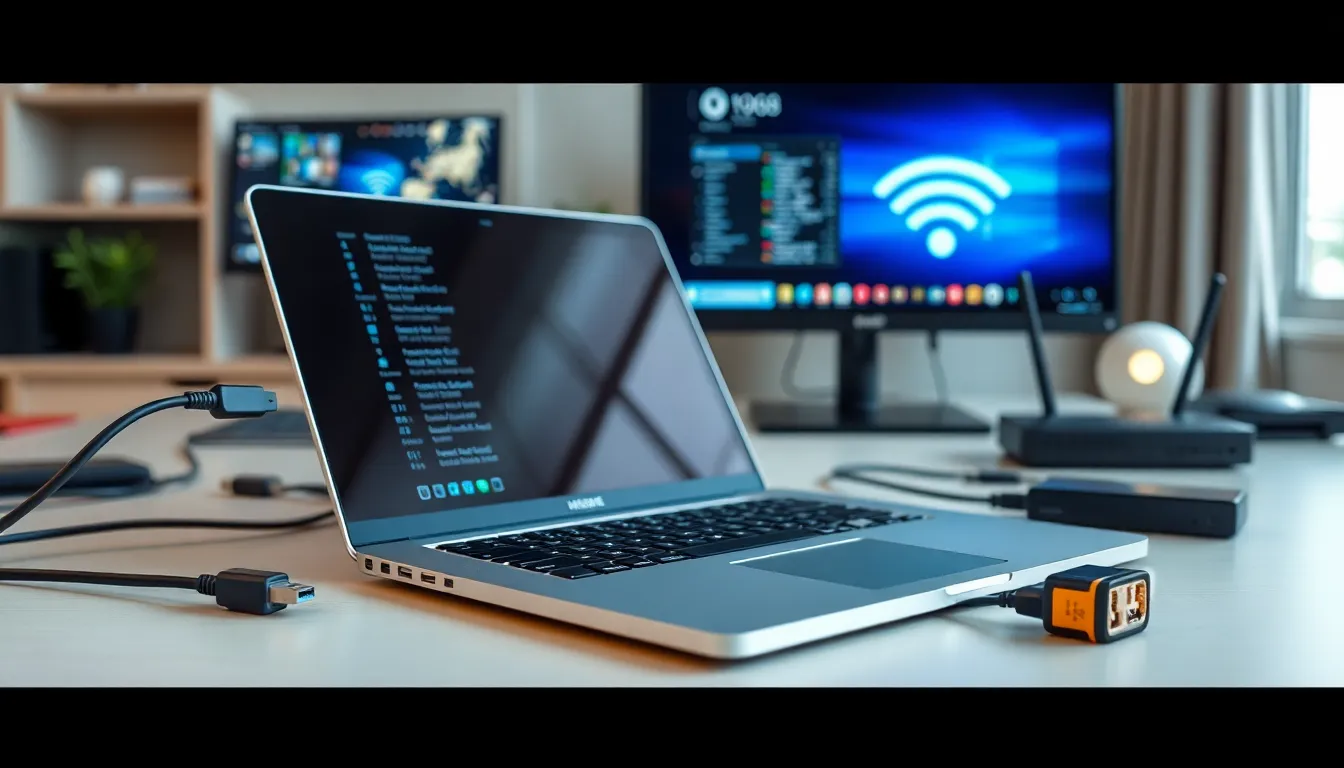Table of Contents
ToggleIn today’s fast-paced digital world, laptop connectivity plays a crucial role in staying productive and connected. Whether it’s for work, school, or leisure, understanding how to optimize connectivity options can make all the difference. From Wi-Fi and Bluetooth to USB and HDMI ports, each connection type offers unique benefits that enhance the user experience.
As technology evolves, so do the ways laptops connect to the world around them. With the rise of remote work and online learning, knowing how to troubleshoot connectivity issues and maximize performance is essential. This article delves into the various connectivity options available, helping users navigate their choices and make informed decisions for their laptop needs.
Overview of Laptop Connectivity
Laptop connectivity encompasses several technologies that enable devices to communicate effectively. Understanding these connection types enhances productivity and user experience.
Wi-Fi
Wi-Fi provides wireless internet access within a specified range. Users can connect multiple devices to a single network, facilitating seamless browsing, streaming, and collaboration. Wi-Fi standards, like 802.11ac and 802.11ax, offer varying speeds and ranges, with 802.11ax providing better capacity and efficiency in crowded environments.
Bluetooth
Bluetooth connects devices wirelessly over short distances. Common applications include audio devices, keyboards, and mice. Bluetooth 5.0 delivers improved range and speed, supporting more connections simultaneously. Compatibility with a wide array of peripherals enhances user convenience.
USB
USB ports connect various devices, including external drives, printers, and docking stations. USB 3.0 and USB-C offer faster data transfer rates, with USB-C also supporting video output and power delivery. The versatility of USB makes it essential for modern laptops.
HDMI
HDMI allows laptops to connect to external displays, such as monitors and TVs. High-definition video and audio transmission makes HDMI ideal for presentations and media viewing. Various HDMI versions support different resolutions and refresh rates, with HDMI 2.1 offering compatibility for 4K and 8K displays.
Ethernet
Ethernet provides a wired internet connection, offering stable and high-speed access. While it requires physical cabling, it reduces latency, making it suitable for gaming and heavy data tasks. Ethernet standards, like Gigabit Ethernet, support rapid data transfers, essential for demanding applications.
NFC
NFC enables short-range communication between devices, commonly used for mobile payments and authentication. This technology simplifies transactions and enhances security during data exchanges. NFC compatibility in laptops showcases its growing significance in connectivity options.
Understanding and leveraging these connectivity types reflect the evolving landscape of technology, ensuring optimal performance and efficiency in various applications.
Types of Connectivity Options

Understanding the various connectivity options enhances laptop performance and productivity. This section details wired and wireless connections, outlining their specific advantages.
Wired Connections
Wired connections offer stability and reliability for data transfer. These options include:
- Ethernet: Provides a direct, stable internet connection, suitable for online gaming and large file transfers. Ethernet supports speeds from 10 Mbps to 10 Gbps, depending on the cable type and network setup.
- USB: Facilitates connections to external devices like printers and external drives. USB standards vary: USB 2.0 offers up to 480 Mbps, while USB 3.0 and USB-C can transmit data at 5 Gbps and 40 Gbps, respectively.
- HDMI: Enables high-definition audio and video transmission to monitors and TVs. HDMI supports resolutions up to 4K with multi-channel audio formats.
- Thunderbolt: Combines data, video, and power in a single connection. Thunderbolt 3 offers data transfer speeds up to 40 Gbps, providing extensive versatility.
Wireless Connections
- Wi-Fi: Delivers wireless internet access with standards such as Wi-Fi 5 (802.11ac) and Wi-Fi 6 (802.11ax), offering speeds of up to 3.5 Gbps and improved range for multiple devices.
- Bluetooth: Connects devices over short distances, such as headphones and keyboards. Bluetooth 5.0 enhances range (up to 800 feet) and data transfer speed (up to 2 Mbps), improving usability.
- NFC (Near Field Communication): Facilitates short-range communication for tasks like mobile payments. NFC operates effectively within a few centimeters, enabling quick authentication processes.
- Wireless Display Technologies: Technologies like Miracast and Chromecast allow screen sharing without cables, supporting presentations or streaming directly to compatible TVs and monitors.
Importance of Laptop Connectivity
Laptop connectivity plays a crucial role in facilitating a seamless user experience across numerous applications. It directly influences productivity levels, particularly in remote work scenarios.
Enhancing Productivity
Enhanced productivity stems from reliable laptop connectivity, allowing users to efficiently access information and communicate with colleagues. High-speed internet connections via Wi-Fi 5 or Wi-Fi 6 support uninterrupted video conferencing and large file transfers, crucial for collaborative tasks. Bluetooth enables quick pairing with peripherals like mice and keyboards, streamlining workflows. USB ports, especially USB-C, allow fast data transfer and charging, ensuring that devices remain operational during intensive work periods. Furthermore, HDMI connections provide the ability to expand workspaces with external displays, improving multitasking capabilities.
Facilitating Remote Work
Remote work greatly benefits from versatile laptop connectivity. Stable Ethernet connections ensure consistent internet access, reducing latency during important online meetings or gaming sessions. Wireless options, such as Wi-Fi and Bluetooth, offer the flexibility to work from various locations without being tethered to a desk. Near Field Communication (NFC) simplifies secure mobile payments, allowing users to complete transactions quickly while on the go. By utilizing these connectivity options, users can maintain productivity levels while adapting to the evolving work environment.
Common Connectivity Issues
Connectivity issues can disrupt productivity and hinder effective usage of laptops. Understanding common problems and addressing them can enhance performance.
Troubleshooting Tips
- Check Network Settings: Ensure Wi-Fi is enabled and airplane mode is off. Confirm the laptop is connected to the correct network.
- Restart Devices: Rebooting the laptop and networking equipment like the router often resolves connectivity conflicts.
- Update Drivers: Keeping drivers up to date ensures compatibility with hardware and operating systems. Regularly visit the manufacturer’s website for the latest updates.
- Run Network Troubleshooter: Use built-in troubleshooting tools in the operating system to diagnose and fix common connectivity problems.
- Examine Cables and Ports: Inspect wired connections for damage. Ensure cables are firmly connected to both the laptop and external devices.
- Interference Check: Identify potential interference from other devices. Move away from microwaves and cordless phones that might disrupt signals.
- Firewall Settings: Review firewall and antivirus settings that might block network access. Temporarily disabling these can help identify the cause of connectivity issues.
Maintenance Best Practices
- Regular Software Updates: Install updates for the operating system and applications to enhance security and improve connectivity functionalities.
- Clear Cache and Cookies: Regularly clearing browser cache and cookies can improve internet performance and connectivity reliability.
- Perform Hardware Checks: Periodically inspect USB ports and connectors for wear. Damage can affect device connectivity.
- Manage Background Applications: Limit the number of applications running simultaneously. Excessive background processes can drain resources, affecting connectivity.
- Secure Networks: Utilize strong passwords for Wi-Fi networks. Ensuring security prevents unauthorized access and potential connectivity issues.
- Use Quality Equipment: Invest in high-quality cables and adapters that minimize signal loss and improve overall connectivity.
- Back-Up Data: Regularly back up important data. In case connectivity issues lead to hardware malfunctions, data loss becomes less likely.
Future Trends in Laptop Connectivity
Advancements in laptop connectivity are set to transform user experiences significantly. Emerging technologies enhance speed, reliability, and versatility.
- 5G Integration
5G technology facilitates ultra-fast wireless connections, offering speeds exceeding 10 Gbps. It enables seamless connectivity for cloud applications, real-time collaboration, and high-definition streaming.
Wi-Fi 6E expands bandwidth, utilizing the 6 GHz band to reduce congestion. This advancement supports faster connections with lower latency, ideal for high-demand environments like remote work and online gaming.
- Bluetooth 5.2 Enhancements
Bluetooth 5.2 introduces improvements like audio sharing and extended range. These enhancements allow users to connect multiple devices simultaneously, creating a more integrated experience across peripherals.
- USB4 Standard
USB4 combines power delivery and data transfer, achieving speeds up to 40 Gbps. Compatibility with Thunderbolt 3 devices fosters greater adaptability in connecting various external peripherals.
- Increased Adoption of Thunderbolt
Thunderbolt 4 enhances connectivity options by supporting daisy chaining multiple devices. With bandwidth of 40 Gbps, Thunderbolt ensures high-speed data transfer for demanding applications.
- Augmented Reality (AR) Integration
Future laptops may incorporate AR technology for improved connectivity. AR applications can offer innovative ways for users to interact with data and collaborate, potentially transforming workflows.
- Enhanced Security Protocols
As connectivity expands, so does the need for security. Future trends likely include stronger encryption and advanced authentication methods to protect user data and maintain privacy.
- Ubiquitous Connectivity Solutions
The future envisions laptops seamlessly connecting to various networks, including public Wi-Fi and mobile hotspots. This capability ensures consistent internet access regardless of location, enhancing user mobility.
These trends indicate that laptop connectivity continues to evolve, promising faster, more reliable, and versatile options that adapt to the growing demands of users in diverse environments.
Laptop connectivity is essential in today’s fast-paced digital landscape. It not only enhances productivity but also improves user experiences across various tasks. By understanding the different connection types available users can make informed decisions that suit their needs.
As technology advances the future of laptop connectivity looks promising with innovations like 5G and Wi-Fi 6E on the horizon. These developments will provide even faster and more reliable connections ensuring users stay connected seamlessly.
Staying proactive with maintenance and troubleshooting can further enhance connectivity experiences. Embracing these technologies will empower users to navigate their work and personal lives more efficiently.








